Questions Regarding the AWP Project
How do I upload Accreditation Content?
How do I find my content on EPiServer?
In the email you received from IT you will see the bulleted list of content items given to you at the project workgroup meeting. Let's use Finances as an example. Please refer to the image below while reading the instructions.
- Navigate to the AWP page in EPiServer.
http://edit-www.umassmed.edu/episerver/cms/#viewsetting=viewlanguage:///en&context=epi.cms.contentdata:///199811 - It will prompt you with a login screen, use your umassmed NT account (the one you use for logging into your computer)
- When you expand the page you see folders with content categories nested within.
- Find your content category, in the screenshot below Finances is expanded as an example.
- For categories that have different infomation for each school (like Finances) you will see a list of the three schools. Expand the school you want to add content under.
- Within this section you can add/edit content, organize as you see fit for now. We may reorganize later.
How do I add Accreditation content to the new site?
Most of the content you will use to populate the AWP site you will find on the existing school sites.
- The easiest way is to open 2 tabs in your browser so you can navigate the site you wish to copy content from in one tab and open in the CMS editor in the other tab
- Begin by finding the accreditation content within your current site or on the schools' sites
- you may want to keep an excel spread sheet of where you found the accreditation content so that page can be updated later
- later in this process, the accreditation content from the existing sites will be replaced with "dynamic content" from the AWP site
- you will receive instructions on how to replace the accreditation content at a later time
- you may want to keep an excel spread sheet of where you found the accreditation content so that page can be updated later
- In the 2nd browser tab where you have the editor open, find the section you wish to add this content
- if a page does not yet exist, create a new one, otherwise edit a current page
- Select and copy the content from the web page from the 1st tab
- paste that content into the editor that is open in the 2nd tab and publish the page In your excel spreadsheet, you may want to have 3 columns to keep track of content for updating the sites later with the AWP content
- title of content
- URL of content on current site
- URL of content on AWP site
How to I get help or training?
Training
To schedule training, you can attend a basic class, an advanced class or request desk side training that can be more specific to your needs. Training sessions are listed on this page:
Support on the Fly
Someone from the web team is at the Genius Bar every week at the following locations and times:
- Main School Lobby (opposite bookstore) - Monday and Wednesday, 10am to 1pm
- South St WolfPack Den - Every 1st & 3rd Tuesday, 10am to 12pm
- Albert Sherman Center (ASC) - Friday, 10am to 1pm
Tips to Review/Edit Content
Is it possible to see when a page was last edited?
Yes, you can. There is a gadget called Versions that will allow you to see the date and time that a page was last published. To enable the Versions gadget:
- Click the tool icon at the top of the site navigation menu and select Add Gadgets.
- On the screen that pops up, scroll all the way to the bottom of the "All" tab and click on "Versions"
- Now you will be able to see the Versions gadget on the main site list.
Listing all pages in a site - Sitemap
A sitemap can be a useful tool for reviewing your data, as it allows you to easily see what pages are on your site, and click through to review them.
Check your site to see if you have a page called Sitemap. If you don't:
- add a new page to the microsite – name it Sitemap
- choose the page type of Site Index Page
- set the microsite it should list (your Microsite Landing Page)
- go to properties view
- default is to have Display in Nav unchecked – leave this as is
- On SEO tab – add a Browser title (sitename sitemap)
- Leave "no index" and "no follow" set up the way it is
- Publish and browse
Finding pages you don't want listed on your sitemap?
Follow the steps below excluding step 4.
NOTE: reemove shortcuts/redirects from sitemap and Search Engine catalogs
Shortcut/redirect pages need to be edited so that they don't show up on the sitemap page. Also, shortcut/redirect pages can result in a negative impact on our search engine optimization with Google. Google views excess redirects as tricking users. Shortcuts are fine to use, we just need to make some edits to help Google understand that this is a legitimate redirect.
- edit the shortcut/redirect page
- click on properties view
- go to the Navigation tab, click on Hide from Sitemp
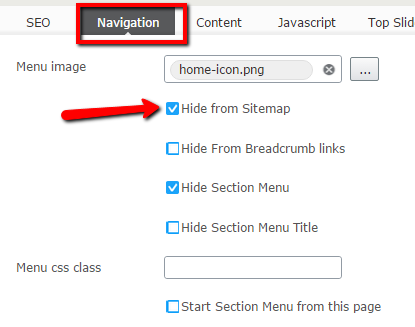
- go to the SEO tab, select the "No Index" checkbox
- also update the Canonical Link field, add the link you are redirecting to
- this tells Google that the real page to index is the one in the Canonical Link field
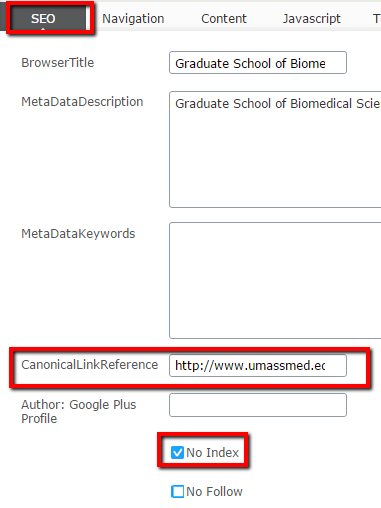
- this tells Google that the real page to index is the one in the Canonical Link field
- also update the Canonical Link field, add the link you are redirecting to
- then publish changes
Searching for and finding old pages and content - Search
On Google, www.google.com, and the UMass Chan site, www.umassmed.edu, search for words that are in the content you are adding to the AWP site. You may want to keep an excel spreadsheet on pages that have incorrect information, ourdated content that should be replaced as well as content that needs to be deleted.
Note: you can make updates to incorrect content now as well as delete content that should no longer be listed. See notes on deleting content farther down on this page.
To help come up with keywords to search:
- start simply - use words that are in the content you are planning to copy
- In Google.com, you can prepend to your search "umassmed:" which will bring results that are on umassmed.edu pages only within the first few results items don't have to review all the results, they will be listed on the first page if any are found
- you will also want to try words that are similar but not exact to see if any other results are returned (may be incorrect content or outdated content that needs to be deleted but is still listed in the search engines or the UMass Chan search engine)
- check your Google Analytics account to see the keywords most people use to get to your site
- don't have an account for your site? Request one via our online form
Once you've performed your searches:
- Are the pages/information current? If not, find the page in your site and either update, delete, or create a redirect to a current site. If the page is not yours, contact the owner and let them know that their content is out of date.
Is it okay for me to delete pages?
Before deleting a page, there are a few questions to consider:
Is the page being replaced by a newer page?
If so, it may be better to redirect the page for a time so that people can still access it using old bookmarks or Google searches. If your page is already cataloged in the search engines, you won't want to loose your SEO rankings (search engine optimization). Generally we recommend at least three months for a redirect to be in place. You can set the page to be archived in 3 months (see the redirect direction farther down on this page)
Is anyone else linking to the page?
If so, make sure you contact the site owners and provide the new link. If you try to delete the page, you will see the locations where the page is linked within EPiServer (see image below). If you suspect sites outside the university are linking to the page, you may want to set up a redirect instead (see the redirect direction farther down on this page).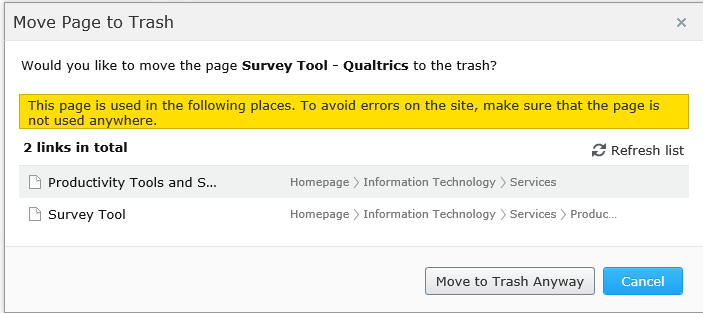
Is it a widely used page?
If so, it may be better to redirect the page for a time so that people can still access it using old bookmarks or Google searches (see the redirect direction farther down on this page)s.
If not, it may be okay to delete the page.
Please note: when deleting many pages, Google will penalize your SEO rankings, which affects all of UMass Chan, for finding too many broken links to your site. When you delete and Google checks the URLs in it's catalog and can't find the page, it will negatively impact your SEO rankings. A few broken links are ok. If you need to delete many pages, someone from IT can help organize this process. You can speak with someone from the IT Genius Bar Monday, Wednesday or Friday about this.
How do I redirect a page?
Please follow the instructions below to turn a page into a redirect.
1. Navigate to the shortcut settings (as shown in the graphic below).
2. Select "Shortcut to page in EPiServer CMS"
3. Select the "..." to select the new page to redirect to.
4. Navigate to the page and click OK.
5. Click "Save". Now users who travel to the old page will be automatically redirected to the new page that you selected.
NOTE: Shortcut/redirect pages need to be edited so that they don't show up on the sitemap page. Also, shortcut/redirect pages can result in a negative impact on our search engine optimization with Google. Google views excess redirects as tricking users. Shortcuts are fine to use, just need to make some edits to help Google understand that this is a logical redirect.
- click on properties view
- go to the Navigation tab, click on Hide from Sitemp

- go to the SEO tab, select the "No Index" checkbox
- also update the Canonical Link field, add the link you are redirecting to
- this tells Google that the real page to index is the one in the Canonical Link field

- also update the Canonical Link field, add the link you are redirecting to
- archive the page to be removed after 3 months (this gove the search engines enough time to remove this page from their catalog and add the new page to their catalog)
- click on the Tools dropdown in the top area

- choose Manage Expiration and Archiving
- pick a date, 3 months from the day you are setting the redirect
- archive to - click the "..." (ellipses) and navigate to and select "zzz-archive"
- click save
- click on the Tools dropdown in the top area
- publish changes
Your redirected page will be in place for 3 months after which it will move to the archive folder and be deleted. The search engines will eventually remove this page from their catalogs.
Sharing the AWP content (using Blocks)
How do I add new content to the AWP area and share with other pages?
Content from the AWP area has already been created and shared with other sites using blocks. This allows us to create shareable pieces of content that can be added anywhere on any page. When the block content is updated, so are all the pages that contain that block.
What if I need to create new content that is not part of an existing block?
Please note, if this is not for accreditation or does not need to exist on the Prospective Students site, you do not need to create a block for AWP.
Navigate to the AWP folder in the Block tree and find the folder where you want the new block to reside. The tree has been set up according to all the content that is needed for accreditation. We should need new foldersr here, but if you do, you may create one.
- create a new Generic block
- you will need to add a new item in Prospective Students if this is required for accreditation
- you can now add this to any page in your school site
Please review the next item: Adding new items to Prospective Students
I maintain content in 2 different sites? How do I do I find the original content when it's in the WYSIWYG area?
The AWP site has been udpated to use blocks so you can now update the content from the block, you no longer have to navigate to the AWP site. Simply click on the block and then click expand the menu and click edit.IT will update everywhere that this block is used.
If the block has been embedded in the main content (the WYSIWYG editor), you can look for it in the AWP site (blocks). Or the easiest way is to view the source code and copy the content ID:
if your block is in the WYSIWYG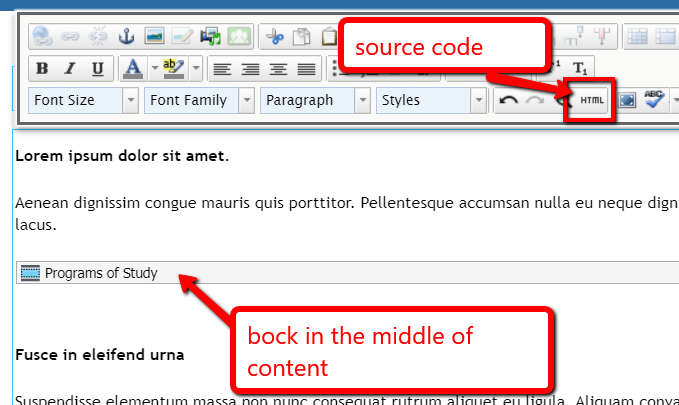
- view the source code (HTML icon in the WYSIWYG tool bar)
- in the source, find a DIV tag that start like
<div data-classid=" ... - look for the data-contentlink and copy the ID
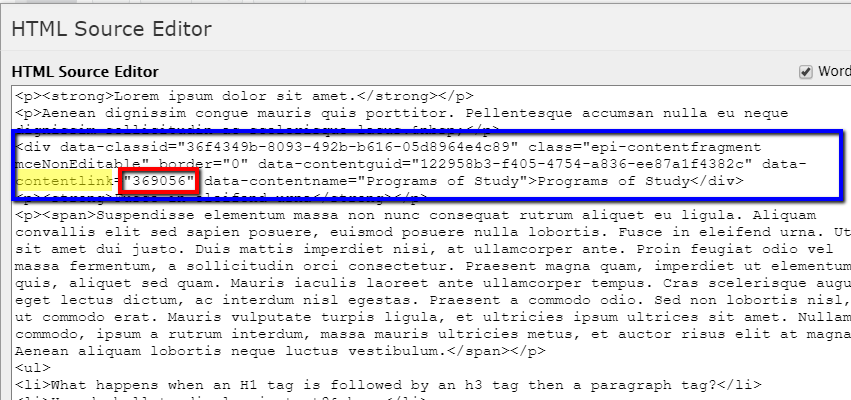
- paste the ID in the search area for Blocks (right panel)

- the block will appear and you can choose to edit it from here (simply double click the block to edit)
How do I add new items to Prospective Students
If this is new content, please make sure you have created a new block as mentioned in the previous item.
- Navigate the Content tree to the PRospective Students site and to the area where you wish to add the new item - there are 5 areas, each area contains subfolders for each school
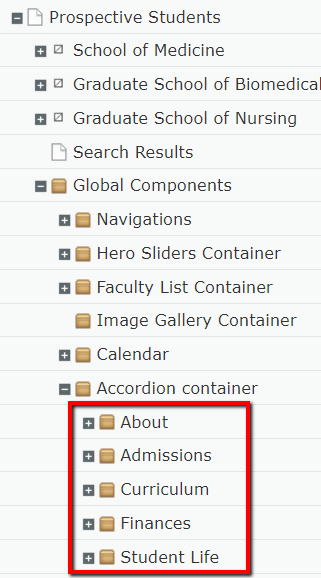

- select the folder you wish to add the new item, click New Page
- choose FAQ Page
- add a page name and question (this will be the headline that shows on the page to be expanded
- in the block tree, navigate to the block(s) you wish to add
- click in the Answer area (you need to do this to activate the editing area)
- click and hold, drag and drop the block(s) into the Answer area
- if you are adding multiple blocks, click in the Answer area again under the block
- drag and drop your next block (you must always click in the Answer area for each block)
- publish
- in another browser window, navigate to the Prospective Student site and view the page making sure it dislpays as you wnt it to
